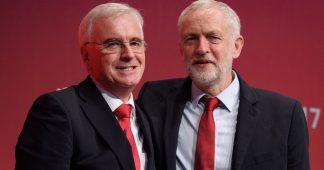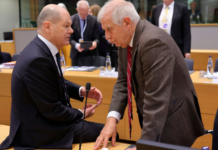Public Capital and Labour’s New Deal
For the first time in its history, the British parliamentary left has a realistic chance of filling the top governmental positions in this capitalist stronghold when the next general election comes. In what follows, I explore the challenges and constraints that a Corbyn government would encounter in tackling the enormous structural imbalances of the uk economy. I set out the policies that have emerged so far from the milieu of Shadow Chancellor John McDonnell, and some additional ideas that might take Corbyn and McDonnell further, if they do take office. My focus will be on economic policy, where social-democratic parties have too often lacked imagination and been gulled by the quack nostrums of Establishment opinion. But first it may be helpful to sketch the contours of the socio-economic landscape a Labour Left government will confront, as a near-decade of Tory austerity policies further corrodes what was already, after Thatcher and Blair, the most inegalitarian, neoliberalized order in Western Europe.
1. maladies of the uk economy
The maladies of the British economy extend back far beyond the present era. Capitalist landowners and City bankers had turned their backs on the uk’s productive economy even before it lost its first-industrializer advantage in the 1870s, preferring the larger returns promised by financial intermediation and mineral extraction. England’s manufacturing bourgeoisie always played second fiddle to this pre-existing ‘gentlemanly capitalist’ ruling class. [1] In the twentieth century, the Empire and its sterling area fostered uneven development at home and abroad, while the Labour Party tailored working-class demands to operate within this top-heavy system. The modernization inflicted by Thatcher in the 1980s did not upgrade manufacturing, as West German and Japanese leaders had done, but famously throttled it with high interest rates, instigating a further shift towards the service sector. At the same time, Thatcher lifted anti-speculative restrictions on the national savings funds: pension plans, insurance policies and mortgages provided the fuel for finance capital’s leveraged take-off. Privatization of public housing and the utilities—gas, electricity, telecoms, water, rail, buses—promised high returns for landlords and shareholders, with no compulsion to commit to long-term infrastructural investment.
Looked at from the City, Thatcher’s ‘Big Bang’ was a great success; but beyond London’s commuter belt, the furnace of financialization was sucking all the oxygen from the air. The hedge funds, privatizers, outsourcers and spread-betting merchants often made a killing, but did not nourish long-term businesses. Manufacturing shrank to 17 per cent of uk gross value added by 1997, compared to 26 per cent in Germany, contributing to a long-term depression in the industrial North as well as a chronic current-account deficit, with Britain importing the goods it no longer made at home. The Blair–Brown governments continued these trends, mitigated only by the few crumbs tossed to ‘hard-working families’ by a tax-credit system which eventually collapsed under the weight of the Chancellor’s micro-tuning. [2] As the uk’s new economic model established itself in the 1990s and began to grow, in global conditions of footloose capital, the country’s sectoral imbalances exacerbated its regional inequalities, too. The service sector ballooned to nearly 80 per cent of output, compared to 69 per cent in Germany, with profits disproportionately reliant on financial and business services based in London and the South-East. [3] Structural imbalances were compounded by the hyper-inflation of London property prices under New Labour; the wealth and income levels of the well-to-do soared relative to the rest. Household debt rose from 85 per cent of disposable income in 1997 to 148 per cent in 2008. [4]
At the same time, the public domain was assiduously plundered of assets. The policy mechanism for this was imported from the us: cut high-end taxes, on the basis that this would free up wealth creation, and then demand spending cuts to balance the books. In the 1980s, Thatcher brought corporation tax down from 52 to 35 per cent; New Labour slashed it to 28 per cent; the Cameron and May governments, to 19 per cent. Beneath the uk’s constitutional flummery—the royal prerogative, the Queen’s speech and an unelected upper house remain intact—much of the state, at local as well as national level, has been systematically privatized and financialized. Government no longer ‘delivered’ public services, but ‘procured’ them. [5] New Labour’s major structural legacy lay here, in hollowing out swathes of public assets and service provision for the benefit of rent-seeking firms, through the expansion of Private Finance Initiatives. Under these schemes, contracting companies establish Special-Purpose Vehicles (spvs) which borrow capital to build and maintain schools, hospitals and prisons, with revenue streams guaranteed for thirty years or more. The Thatcher and Major governments had already experimented with pfis. Blair and Brown went on to adopt them on a much larger scale, advised by their friends in the City that ‘partnering’ with finance capital would be a more providential way of raising resources for school- and hospital-building programmes than imposing higher taxes on wealthy corporations and the rich.
The pfi mania reflected the broader transition in the British economy from production to services, under the aegis of financialized capitalism. Rent-seeking is the characteristic profit-form of this regime, with its privatized, leveraged assets—land, buildings, patents, airwaves, mineral deposits, digital platforms and so forth—and the spv as its preferred legal entity. [6] In the short run, rents can reap windfall rewards; but in the longer term, the production of new values does more to boost productivity. Originally devised for major infrastructure projects like roads and hospitals, the pfi formula was extended into waste disposal, transport, facilities management, social care, it, military equipment, security provision and energy supplies. [7] These lucrative contracts were not allotted in a genuinely competitive market but instead doled out amongst a handful of companies—Balfour Beatty, Carillion, Interserve, Jarvis, Kier, Serco. [8] Public agencies duly signed up to over £300 billion in unitary charges covering debt repayments, financing costs, maintenance fees and additional charges, down to the 2040s—a huge taxpayer hand-out to the private sector. [9] The crisis of 2008 was not allowed to halt the revelry: Brown set up a Treasury Infrastructure Finance Unit to pump public credit to the pfi investors, who then ‘invested’ it back into public projects. [10]
As well as extra financing costs and the inordinate repayment period, pfis brought a deterioration in public-sector service standards and democratic accountability. The financial engineering embodied by the spvs did not boost underlying performance—quite the reverse: it produced managers without industry-specific skills or local knowledge, and demoralized, underpaid employees, contributing to the poor productivity that has characterized the British economy for decades. [11] At 17 per cent of gdp, the uk investment rate is 5 percentage points below the oecd average and disproportionately concentrated in London and the South East. r&d spending is notably weak as well—1.6 per cent of gdp, compared to 2.1 per cent in the Eurozone and 2.8 per cent in the us. Meanwhile the proportion of non-financial corporations’ discretionary cash-flow funneled to shareholders has risen from 39 to 46 per cent since 1990, with a growing percentage now flowing overseas. The uk also has lower tax receipts as a percentage of gdp than its neighbours: 33 per cent, compared to 38 per cent in Germany and 45 per cent in France. [12]
The 2008 crisis revealed the staggering private-debt levels that sustained the financialized uk economy: household debt at 98 per cent of gdp, non-financial corporations at 109 per cent, financial corporations at 219 per cent—or 750 per cent, if derivatives were included—the highest of any G7 economy. When public debt of 81 per cent was included, the uk’s total liabilities before the crash were 487 per cent of its gdp—higher than Japan’s. [13] When the crisis hit, all stops were pulled out to save the bloated financial sector: a total of £1.2 trillion in bank bailouts and guarantees, followed by £445 billion in quantitative easing between 2009 and 2016. [14] As the Eurozone crisis struck, the headline figures of Britain’s recovery looked impressive: by 2015, gdp was up 14 per cent from its 2009 trough, wealth had grown by 35 per cent. But even the Bank of England’s chief economist could ask: ‘Whose recovery?’ [15]
The public cash poured into the financial sector fuelled another stock-market and property bubble in London and the South East, where median wealth has risen nearly 50 per cent since the crisis and incomes of ftse 100 chief executives quadrupled between 1998 and 2015. Meanwhile the austerity that was supposed to pay for all this has hit hardest in the North, more heavily dependent on public-sector jobs. Average real wages are still below their 2008 level. Local council spending in England was cut by 26 per cent on average under the Conservative–Liberal Democrat coalition, and public-sector pay was capped—school teachers, working a 55-hour week, saw their real pay drop by 15 per cent. Personal debt is rising again, especially among the young, now saddled with huge student loans on graduation; many are struggling with repayments. Harsh cuts in housing benefit have seen poverty levels running at over 20 per cent for those of working age; there has been a rise in people sleeping rough, in job insecurity, in anxiety and depression. [16] In June 2017, the fire at Grenfell Tower provided a horrific example of the declining safety standards abetted by corrupt procurement practices and outsourced responsibility. [17] The collapse in early 2018 of Carillion, the country’s second largest construction company, revealed the gimcrack nature of British infrastructure provision and maintenance in the era of the pfi. Despite profit warnings, Carillion had been handed a number of large public-sector contracts just months before it fell. [18]
2. a turning tide?
These were the conditions in which Corbyn’s radical message struck a new note. Contingent factors—above all, the unintended consequences of Edward Miliband’s switch to open primaries and ‘one member, one vote’ for the 2015 Party leadership election—propelled him to the attention of the public, where his programme for structural change could catch the wind of popular discontent with a system that was patently failing for much of the country. Having virtually disappeared during the Blairite ascendancy, the Labour Left has sprung back to life. With its origins in Keir Hardie’s Independent Labour Party and low-church (Quaker, Methodist) traditions, the Labour Left has always supplied the conscience of the party—its ‘beating heart’, supplemented by the ‘brains’ of the Fabians and their neoliberal avatars, and the financial ‘brawn’ of the trade-union bureaucracies. [19] Within the party’s sui generis structures, the Left’s base has been the membership, the unions controlled the apparatus, conference and the National Executive Committee, and the Labour Right held sway in Parliament. In its time, the Labour Left supported novel campaigns against nuclear weapons, colonial oppression and the misdeeds of its own party in government, but remained trapped within the ideology of Labourism and its deference to uk institutions.
Read more at https://newleftreview.org/II/111/robin-blackburn-the-corbyn-project











